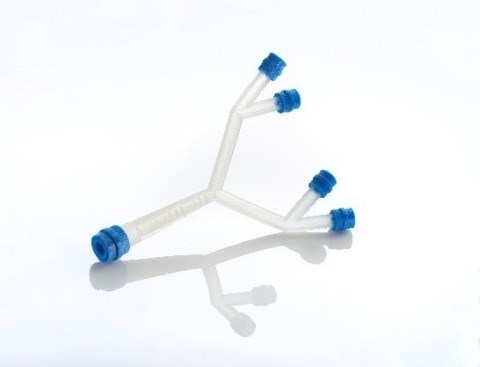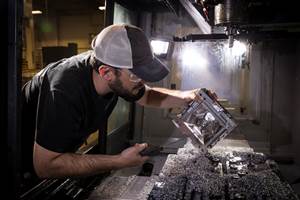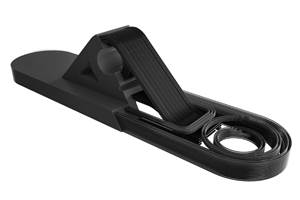Additive Mfg. Materials Evolve as Market Moves from Prototyping to Production
Both Stratasys and Arkema have recently launched new materials with improved aesthetics and performance.

Within the last few years, as additive manufacturing has burgeoned with new and optimized 3D printing equipment, materials development has been surging along as well.
In fact, experts in the technology have long professed that in many respects materials hold the key to the advancement of additive manufacturing—particularly as the trend toward short-run manufacturing grows. Two companies have recently introduced new materials.
Stratasys has added to two new materials to its 3D printing materials portfolio—one designed for the FDM process, and one for the PolyJet process.
● FDM Nylon 12CF, is a carbon fiber-filled thermoplastic strong enough to replace metal components in a range of applications. It is said to be ideally suited for a wide range of final part and tooling applications where the combination of stiffness, strength and low weight is critical to the performance. Examples include drill guides, end-of-arm tooling, brackets, jigs, fixtures, and even metal-forming tools.
“We believe that the impressive strength-to-weight ratio of the FDM Nylon 12CF is transforming for many industries from consumer goods and recreational goods to automotive and aerospace… it enables designers to develop more practical and functional designs and gets them to market faster, without worrying about how to prototype those parts using metal or molding,” said v.p. Zehavit Reisin, head of Rapid Prototyping for Stratasys.
The FDM Nylon 12CF is designed for the Fortus 450mc Production 3D Printer and is compatible with soluble support SR-11-. It requires and updated version of Insight software and a hardware upgrade. The material can produce parts in a layer thickness of 0.010 in. (0.254 mm). It is expected to start shipping in Q2 2017.
See video:
● The Agilus30 family—Agilus30 and Agilus30 Black—is designed for designers and engineers that need to simulate flexible materials. It is said to allow for greater freedom to handle and test flexible parts and prototypes while delivering excellent accuracy, fine details and enhanced product realism.
The Agilus30 family’s all-around rubber-like performance and compatibility with soluble support (SUP706) reportedly makes these materials an excellent choice for modeling delicate parts that undergo flexing and bending. It is expected to generate interest for mechanical engineers, RP managers and industrial designers. Examples of applications include overmolding, soft-touch, and living hinges, hoses, seals and gaskets, as well as knobs, grips, pulls, and handles. Agilus30 is compatible with Objet260/350/500 Connex1/2/3 Printing platforms and is available for shipping now.
See video:
Meanwhile, at next week’s (March 19-23) 2017 Additive Manufacturers User Group (AMUG) conference and expo in Chicago, Arkema will highlight recent advances in high performance nylons, PVDF, PEKK, and photocure resins. The company notes that as the industry turns from prototyping to short-run manufacturing, exciting polymer advances have resulted in improvements in both aesthetics and mechanical performance for the life of manufactured parts. The company will also present two technical papers:
“The First Polyamide 11: The High Performance Material of Choice,” by technical polymers development manager Arnard Lemaitre, entails Arkema’s Invent nylons for powder bed fusion and specifically address the mechanical properties required for manufacturing end-use parts.
“Block Copolymer Assembly for 3D Printing,” by William Wolf, technical service engineer for Sartomer, an Arkema subsidiary and leading global supplier of specialty acrylates and methacrylates, will address new developments in the N3xtDimension product line for photo-curable 3D printing materials. The company commercially launched this family of UV-curable materials last November. Said to represent the best in class performance for acrylate-based systems, this family of resin now spans a large range of viscosities offering broad tailorability—from formulation flexibility to drop-in systems to meet individual user requirements.

Related Content
How Additive Manufacturing Can Help, not Hinder, Injection Moldability of New Designs
Four cost drivers—design for moldability, mold-base size, internal componentry, polish/custom finishing—dictate the financial and processing success of a molded part design. Learn how 3D printing can assist this process, while also understanding its potential pitfalls.
Read MoreLarge-Format “Cold” 3D Printing With Polypropylene and Polyethylene
Israeli startup Largix has developed a production solution that can 3D print PP and PE without melting them. Its first test? Custom tanks for chemical storage.
Read MoreAdditive Fusion Technology Optimizes Composite Structures for Demanding Applications
9T Labs continues to enhance the efficiency of its technology, which produces composite parts with intentionally oriented fibers.
Read More420 Stainless Steel Now Qualified With TrueShape 3D Printing Technology
NPE2024: Mantle's Additive Manufacturing Technology is Designed for Precision Tooling
Read MoreRead Next
Troubleshooting Screw and Barrel Wear in Extrusion
Extruder screws and barrels will wear over time. If you are seeing a reduction in specific rate and higher discharge temperatures, wear is the likely culprit.
Read MoreWhy (and What) You Need to Dry
Other than polyolefins, almost every other polymer exhibits some level of polarity and therefore can absorb a certain amount of moisture from the atmosphere. Here’s a look at some of these materials, and what needs to be done to dry them.
Read MoreHow Polymer Melts in Single-Screw Extruders
Understanding how polymer melts in a single-screw extruder could help you optimize your screw design to eliminate defect-causing solid polymer fragments.
Read More


























